
Introduction Hip Flexor Exercises
Hip Flexor Exercises. As we age, we experience hip pains partly due to the weakness of the hip muscles. However, learning how to strengthen your hips, with hip-strengthening exercises is vital to prevent or reduce severe pain. Consequently, the pain may get so severe that it results in abnormal gait, incorrect posture. Also, the inability to stand for long without losing balance, thus affecting our activities of daily living. In fact, back pain, plantar fasciitis, shin splints, IT band syndrome, and knee pain. Also, have been associated with dysfunctional hip muscles. Because, this to a large extent is due to the weakness of the hip stabilizers.
The hip muscles provide stability by evenly distributing the load of our torso to our lower limbs. The instability of the hip can cause an uneven distribution of weight throughout the body, thus having a detrimental effect on the spine. When the hip muscles are strong, they improve the knees’ stability and reduce knee pain, thereby enhancing the overall stability of the body. Here, hip muscles are divided into four groups based on their orientation around the hip joint:
- the adductor group
- the gluteal group
- the iliopsoas group
- the lateral rotator group
How they work
Hip Flexor Exercises. All of these muscles work together in maintaining a standing posture. Besides, they enable us to have correct posture, by working an integrated system. Such as, with the supporting muscles of the spine, muscles of the lower leg, core, neck, and shoulders.
Over time, bony structures change, and they start breaking down faster than they form. Subsequently, the wear-and-tear our bones sustain over time takes a toll and we become more liable to injury. A good hip workout that targets these muscles can be beneficial in fall prevention, relieving aches, and makes movement easier. Below are specific hip strengthening exercises for older adults.
Hip Circles
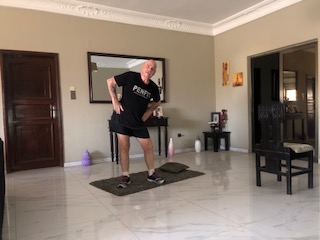
Hip Flexor Exercises. These hip circles target virtually all of your hip muscles. It’s great for increasing general leg mobility, and particularly strengthens the glute which provides support to the hip. Strong glutes keeps your hips stable, relieves stress and tension, and increases hip flexibility.
- Stand upright with your feet a little wider than shoulder-width apart.
- Bend your knees slightly and place your hands on your hip.
- Slowly rotate your hips, making big circles, keeping your toes planted on the ground.
- Complete a set of 5 in a clockwise direction.
- Repeat a set of 5 counter-clockwise.
- So then complete 3 sets
If you experience difficulty balancing during this exercise, reduce the circle sizes or hold onto a sturdy object for support.
Standing Hip Extension (SHE)
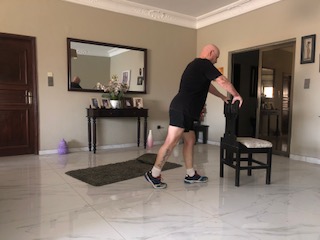
This exercise targets the gluteus muscles, ensures pelvic alignment, and gives support to the lower back. It improves the strength and stability of your glute, thus challenging balance.
- With your shoulders wide apart, keep your back straight while standing.
- Make sure your knees are straight and locked.
- Keep your hands on your hips for stability, extend your right leg back, keeping your toes on the ground. Your legs will create a triangle-like position.
- Gently extend your right hip backwards without arching your back.
- Return your foot to the initial position and repeat 5 times.
- Repeat 5 times for the other leg.
Standing Hip Flexor (SHF)
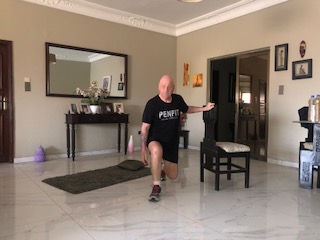
The SHF stretches the front hip flexors. It is a good exercise especially for seniors with lower back pain and beneficial for building hip flexor strength.
- Stand with your feet apart and hands on your hip.
- Step your left foot forward about a foot and a half.
- Slowly bend your left knee, and lift your right heel off the floor.
- Lean forward and squeeze your right glute in this position. Hold for 30 seconds.
- Repeat on the other side. This time, right foot forward.
To make it easier, hold onto a chair or wall to help maintain balance. If you encounter any discomforts, leave this position, and straighten your spine.
Side Hip Raises
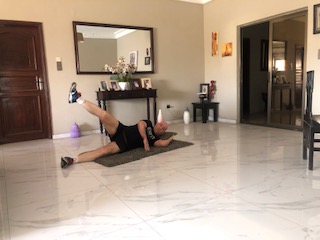
This is a hip stabilizing exercise and builds the strength of your obliques, which are responsible for moving the spine, as well as stabilizing the pelvis and lower back.
- Lay on your right side on your mat. Use a pillow/towel for cushioning as needed.
- Place your forearm on the floor to help stabilize your weight, if needed.
- Slowly raise your left leg up, as far as is comfortable, and slowly bring it back down to meet the right leg. Slow is the key here; try to count to at least 5 as you bring your leg up and down.
- Repeat 5 times, roll over to lay on your left side and repeat, raising your right leg.
This exercise requires coordination and strength, so it’s crucial to keep your breathing steady.
Butterfly Pose
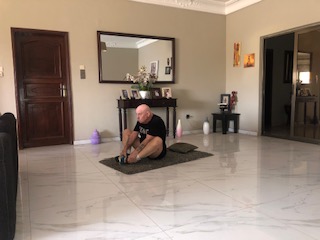
The butterfly pose works on both your flexors and adductors. It enhances flexibility in your lower back, loosening up your groin, hips, and inner thighs muscles which draws your legs together. This helps to maintain stability and balance, as well as stimulate blood flow.
- Sit tall on the floor; envision a string attached to your back, bringing you to sit straight up in great posture.
- Bend your knees and ensure the soles of your feet touch at the centre in a butterfly position.
- With an erect spine, grab hold of each foot with your hands. Inhale to prepare, and exhale while lowering your torso forward. Hold when you feel the stretch.
- Maintain this pose for 60 seconds. Repeat 5 times. But if that is difficult do what you can manage
If this stretch feels too easy, bring your feet closer to your body to extend the hip muscles more.
Video
In Conclusion
Your hips are an essential part of everything you do, so start stretching and strengthening them. So when done regularly, these exercises can make a big difference to your mobility and balance. Also, these can improve your daily life over time, so make sure you do them daily.
Important Note *
Remember that everyone is different, and it is ultimately YOUR RESPONSIBILITY to find what your body responds to. So please do your due diligence before trying anything new, including getting Medical Advice to ensure your safety and peace of mind.
Connect with me and leave a comment or two on my social media.
3 replies on “Hip Flexor Exercises”
Good day, I follow all your posts. I had hip replacement 3 years ago. When I saw your Jumping exercise I was skeptical but I tried ONE jump. I suffered lower back pain for a week. Was even thinking it could be my kidneys. That is the only exercise that was a mistake for me. I learned. Cannot jump, cannot run. Do you have any advice? I will be 84 in June. Thank you so much.
Hi Artemida, I usually answer comments within a couple of days, and I check periodically that I have answered them all, so today I cannot find an answer to you, so let me apologise for the late reply, So it is always best to speak to your doctor before starting any new exercise, but you say you have a hip replacement, and my advice is be careful, always check with your doctor first, thank you for your comment, all the very best Ian
I am 73 and find your exercises are helpful. Great thank you from Sri Lanka.